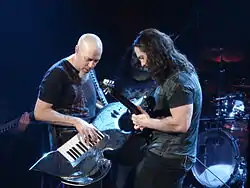
A keytar is a keyboard or synthesizer hung around the neck and shoulders, similar to a guitar.
List of keytars
- [no grip] ^ ^ ^ ^ ^ ^ ^ ^ — keyboard model without control grip.
- [opt grip] ^ ^ — keyboard model with optional control grip.
| Dates | Model | Type | I/F | Notes |
|---|---|---|---|---|
| 1795 | Orphica[1] | acoustic piano | – | a portable miniature piano in horizontal harp form. |
| 1963 | Weltmeister Basset[2] | electric bass piano using struck reed | – | an electric piano bass, similar to Hohner Bass or Rhodes PianoBass, used by dance bands in East Germany probably late 1960s. |
| 1966 | Joh Mustad Tubon[3] (in the UK: Livingston)[4] | electronic bass organ | – | tube-shaped monophonic electronic keyboard instrument with guitar strap. Used by Ralf Hütter of Kraftwerk on the album Kraftwerk (1970),[4][5] Swedish and Finnish bands during the 1970s, including Lådan.[6] |
| 1977 | Hillwood Rockeyboard RB-1[7] | synth piano with VCF & volume pedals[7] | – | influenced by Edgar Winter's style of hanging a keyboard from a neck. Used by Haruo Chikada (The Vibratones). |
| 1977[8] | Powell Probe | controller | (CV/Gate) | Roger Powell's keytar by Royalex |
| 1979 | PMS Syntar[9] | synthesizer | (CV/Gate) | an earliest synthesizer keytar product, prior to the Moog Liberation in 1980 |
| 1980 | Davis Clavitar | controller | (CV/Gate) | used by George Duke, Herbie Hancock in 1980. |
| 1980 | Moog Liberation | synthesizer | CV/Gate | |
| 1980 | Royalex Probe | controller | (CV/Gate) | Jan Hammer's keytar by Royalex, ca. 1980. |
| 1982 | Dynacord Rhythm Stick (Jamma)[10] | percussion controller | MIDI & CV/Gate | used by Michael Jackson (1996-7), Billy Ocean, Sabrina Salerno (1988), Manu Katche, and Curt Cress.[11] |
| 1982 | Roland SH-101[opt grip] | synthesizer | CV/Gate | control grip was optional. |
| 1982 | Sequential Circuits Remote Prophet | controller | SCB | controller for Prophet-5 synthesizer using proprietary serial interface.[12] Used by Geoffrey Downes of ASIA and Dave Stewart. |
| 1982 | Yamaha CS01[no grip] | synthesizer with optional breath controller BC1 or BC2 | CV/Gate | used by Chick Corea in the early 1980s. |
| 1983 | Yamaha KX1 | controller | MIDI | used by Herbie Hancock in 1983, George Duke in 1983. |
| 1983 | Korg Poly-800[no grip] | synthesizer | MIDI | |
| c. 1983 | Yamaha CS01II | synthesizer with optional breath controller BC1 or BC3 | CV/Gate | |
| c. 1984 | Korg Poly-800 MkII[no grip] | synthesizer | MIDI | |
| 1984 | Casio CZ-101[no grip] | synthesizer | MIDI | a medium size keyboard with strap pins |
| 1984 | Korg RK-100 | controller | MIDI | |
| 1984 | Yamaha KX5 | controller | MIDI | a medium depth keyboard |
| 1985 | Lync LN1 (The Lync) | controller | MIDI | |
| 1985 | Roland AXIS | controller | MIDI | |
| 1985 | Yamaha DX100[no grip] | synthesizer | MIDI | a mini keyboard with strap pins |
| 1986 | Casio AZ-1 | controller | MIDI | |
| 1986 | Siel DK70[opt grip] | synthesizer | MIDI | control grip was optional |
| 1987 | Korg 707[no grip] | synthesizer | MIDI | a synthesizer with strap pins |
| 1987 | Yamaha SHS-10 | electronic keyboard | MIDI | |
| c. 1987 | Tyco HotKeyz | toy keyboard | – | a toy keyboard |
| 1988 | Lync LN4 | controller | MIDI | also Jan Hammer signature model existed. |
| 1988 | Yamaha SHS-200 | electronic keyboard | MIDI | |
| 1989 | Tsumura JD21[13] | percussion controller | MIDI | |
| 1990 | Lync LN1000 | controller | MIDI | |
| c. 1990 | Formanta Mini | synthesizer | (MIDI) | |
| 1991 | Junost 21 | synthesizer | (MIDI) | |
| c. 1992[14] | Baldoni MIDI Accord[15] | accordion controller ? | MIDI | Strap-on keyboard controller in the keytar style, with the chromatic buttons on the left-hand, and piano keyboard on the right-hand.[16][17] |
| 1993 | Roland AX-1 | controller | MIDI | |
| 1994 | Zendrum | percussion controller | (MIDI) | |
| 1995 | The Drumstick | percussion controller | (MIDI) | used by E. Dr. Smith[18] |
| c. 2000 | Suzuki MK-3600 YAMAHA YMK-80 | electronic keyboard | MIDI | a keyboard for marching band |
| 2000 | Lag LeKey | controller | (MIDI) | |
| 2001 | Roland AX-7 | controller | MIDI | |
| c. 2002 | Casio SA-75 | electronic keyboard | MIDI | a mini electronic keyboard with handsfree microphone and strap pins |
| c. 2007 | Zen Riffer Solo Axe | controller | (MIDI) | |
| 2008 | Behringer UMA25S[no grip] | controller | USB & MIDI | |
| 2009 | Roland AX-Synth | synthesizer | USB & MIDI | |
| 2009 | Stoneboard | controller | MIDI | |
| 2010 | Politrep[no grip] | controller | MIDI | |
| 2010 | Roland Lucina AX-09 | synthesizer | USB & MIDI | |
| 2010 | Mad Catz Rock Band 3 Wireless Pro Keyboard | controller & video game controller | MIDI & console specific | |
| 2012 | Alesis Vortex | controller | USB & MIDI | |
| 2014 | Alesis Vortex Wireless | controller | USB & MIDI | first keytar with wireless USB connection to a PC or laptop |
| 2014 | Korg RK-100S | synthesizer | USB & MIDI | used by Rick Astley in 2016 |
| 2017 | Yamaha Vocaloid Keyboard | synthesizer | USB,[19] Bluetooth LE[20] | To be released in "Winter 2017".[21] First wearable prototype in 2014;[21] limited rental available in 2015 [22] |
| 2018 | Alesis Vortex Wireless 2 | controller | USB & MIDI | |
| 2018 | Roland AX-Edge | synthesizer | USB, MIDI, Bluetooth LE | |
| 2019 | Behringer MS-101 | synthesizer | USB & MIDI | Clone of the original 1982 Roland SH-101 |
| 2019 | Yamaha Sonogenic SHS-500 | electronic keyboard | USB, MIDI, Bluetooth LE | Built-in speaker |
| 2019 | Yamaha Sonogenic SHS-300 | electronic keyboard | USB | Built-in speaker |
| 2018 | Yamaha Vocaloid VKB-100 | electronic keyboard | USB, MIDI, Bluetooth LE | Built-in speaker |
| 2020 | Korg RK-100S 2 | synthesizer | USB & MIDI | Wooden body and new programs |
Custom/rare keytars
Rare keytar products
- Delmar Brown "Illuminator" (illuminating display attached to keytar)
- Guess Musical Instruments "Schizotron", a product which combined keyboard and guitar/bass
- "Nissin C-16", a custom keytar version of Casio SK-1, distributed as lottery goods for promoting Nissin Cup Noodles
- Suzuki "Omnichord" and "QChord", electronic chord instruments inspired by Oscar Schmidt Autoharp
- "Zen Riffer", used most notably by Jordan Rudess of Dream Theater.
Drum/Percussion keytars
Custom made keytars
- In alphabetical order:
- "Alien Guitar Simulator", a selfmade keytar by Le Orme keyboard player Michele Bon.
- "Arcadetar", a keytar-like keyboard controller combined a pitch sensor in 20 inch. (50 cm) long, developed by Italian musician Andrea Lomuscio of Teapot Industries in 2012.
- Jeri Ellsworth's FPGA-based C64 keytar[23]
- Lady Gaga's custom made keytar during The Monster Ball Tour in 2010.
- "Lag Circulaire" made for Jean Michel Jarre
- "Lag Insecte" made for Jean Michel Jarre
- "Lag Mad Max" made for Jean Michel Jarre
- Matthew Bellamy's "Keytarcaster" Manson, made for playing Undisclosed Desires from Muse's 5th studio album, The Resistance
- Prince's "PurpleAxxe", also played by Tommy Barbarella
- "Politrep", a copy of the Zen Riffer keytar made by order at the website space4keys.com
- "Remote" for Jean Michel Jarre's studio by Lag
- "Syblade", a keytar designed to be unique and to inspire.
Customized keytars
- Based on minimoog keyboards
- Custom minimoog keyboard used by Gary Wright and Steve Porcaro around 1976.
- Cruder, Jan Hammer's early custom keyboard with block shaped controller.[24]
- Plexi minimoog keyboard used by George Duke
- Based on Yamaha KX series
- Jean Michel Jarre's custom KX5, two versions: Houston and Docklands Concerts.
- Lights Poxleitner plays a rare Yamaha KX5 keytar.
- Based on Roland AX series
- Vadim Pruzhanov of DragonForce and Henrik Klingenberg of Sonata Arctica both use a custom Roland AX-7 (although nowadays Henrik Klingenberg uses custom Roland AX-1)
- Christopher Bowes of Alestorm owns a Roland AX-7 which he has customised over the years with various stickers of animals.
- Jeff Abbott, long-time keytar player and product demonstrator for MusicLab plays a custom wooden keytar based around a Roland AX-1.
Gallery
 Orphica (18th–19th century)
Orphica (18th–19th century)_operated_by_Lucy_Hosking_(Lucyfer)_to_play_the_Satan's_Calliope%252C_the_flaming_pipe_organ_car_by_him_(Burning_Man_2006).jpg.webp) Royalex Probe (1977/1980) played by Lucy Hosking
Royalex Probe (1977/1980) played by Lucy Hosking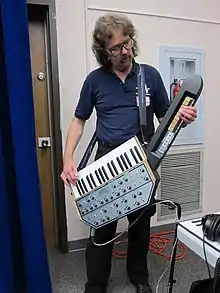 PMS Syntar (1979) by George Mattson
PMS Syntar (1979) by George Mattson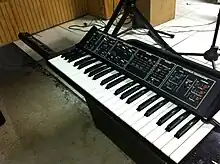 Moog Liberation (1980)
Moog Liberation (1980)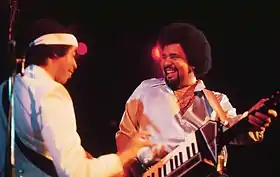 Davis Clavitar (1980) played by George Duke
Davis Clavitar (1980) played by George Duke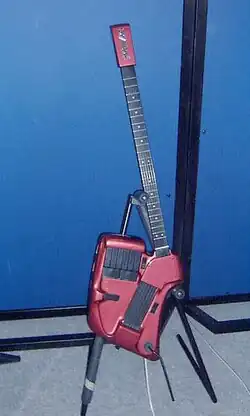 SynthAxe (1985) by Bill Aitken, et al.
SynthAxe (1985) by Bill Aitken, et al. Yamaha KX-5 (1984)
Yamaha KX-5 (1984) Korg RK-100 (1984)
Korg RK-100 (1984) Yamaha SHS-10 (1987)
Yamaha SHS-10 (1987) Lync LN-1000 (1990)
Lync LN-1000 (1990).jpg.webp) Zendrum series (1994)
Zendrum series (1994) Roland AX-7 (2001)
Roland AX-7 (2001) Zen Riffer Solo Axe (2007) by Roy Wooten
Zen Riffer Solo Axe (2007) by Roy Wooten Mad Catz Rock Band 3 Wireless Pro Keyboard
Mad Catz Rock Band 3 Wireless Pro Keyboard.jpg.webp) Korg RK-100s (2014)
Korg RK-100s (2014) Alesis Vortex Wireless (2014) played by Jean Pageau (Mystery) in 2019
Alesis Vortex Wireless (2014) played by Jean Pageau (Mystery) in 2019
See also
Wikimedia Commons has media related to Keytars.
References
- ↑ "Orphica (?Vienna, c. 1805)". Centre for Performance History, Royal College of Music. Archived from the original on 2011-09-28. Retrieved 2011-10-10.
- ↑ "Weltmeister Basset". blackroses.de. Archived from the original on 2002-03-22.
- ↑ "Joh Mustad AB Tubon (1966, Sweden)". Stockholm Music and Theatre Museum. Archived from the original on 2012-04-22.
- 1 2
"The 'Tubon' Joh Mustad AB, Sweden, 1966". 120 Years of Electronic Music (120years.net). 9 February 2014.
The instrument was manufactured by in 1966 by the Swedish manufacturer of electronic tube organs, Joh Mustad AB, in Gothenburg, Sweden and also sold under license in the UK as the 'Livingstone'. Very few of the instruments were sold outside of Sweden but one was purchased by Paul McCartney ( the original score for 'Strawberry Fields Forever' includes a Tubon intro which was replaced by a Chamberlin on the final recording) and by Ralf Hutter of Kraftwerk in the early 1970s.
See also: photographs of Paul playing Tubon 1, 2 (at the Schloss Hotel in Hamburg, during The Beatles' last world tour), Tubon part score of "Strawberry Fields Forever". - ↑
Sean Albiez; David Pattie, eds. (January 2011). "Kraftwerk (1970)". Kraftwerk: Music Non-Stop. A&C Black (published 2011). pp. 100–101. ISBN 978-1-4411-9136-6.
It is also worth mentioning the use of phasing and the application of ring modulator effects to the keyboard's Tubon sound, which gives the music an industrial quality.
- ↑ "Lådan: Va i helvete har dom för sig inne i banken efter tre?". YouTube.
- 1 2 "Rockeyboard RB-1". Hillwood Keyboard / Synthesizer Catalog 1977. Hillwood Musical Instrument/Zen-On. Archived from the original on 2012-06-08. Retrieved 2011-10-10.
- ↑ "Blog: The Keytar - A Brief History". Sonicstate. Retrieved 15 February 2022.
- ↑ James D. Maier. "The Performance Music Systems Syntar".
- 1 2 "The Jamma & Dynacord Rhythm Stick official site". — including the stories, photographs, videos, technical stuffs and manuals (see below).
- Dynacord Rhythm Stick MIDI - operating manual. Dynacord.
- UK application 8,423,427, Jones Peter Stephab (Dynacord Electronic-Und Geratebau GmbH & Co.), "A Music Synthesizer, Especially Portable Drum Synthesizer", published 1984-09-17 (EP 0195038 A1 (published on 1986-09-24), WO 8601927 A1)
- US patent 4,867,028, Peter S. Jones (Dynacord Electronic-Und Geratebau GmbH & Co.), "Music Synthesizer Especially Portable Drum Synthesizer", issued 1989-09-19 (a continuation of co-pending application Ser. No. 871,442, filed as PCT EP85/01927 on Mar. 22, 1986, now abandoned.)
- ↑ Graham, Alex (2019). Electronic Drumfax. self-published. pp. 121, 122. ISBN 978-1701024229.
- ↑ Reid, Gordon (March 1999). "Sequential Circuits – Prophet Synthesizers 5 & 10 (Retro)". Sound on Sound. Archived from the original on 3 February 2016. Retrieved January 23, 2015.
- 1 2 "JD21 official manual" (in Japanese). Tsumura Inc.
- ↑ Kozak, Donald P. (1992). A Guide to Computer Music: An Electronic Music Resource. Sound Management. p. 69. ISBN 978-0-9621514-2-2.
Manufactured by Baldoni MIDI Accord
- ↑ "n/a". Electronic Musician. Vol. 11, no. 1. 1995. p. 8.
... I know of at least one other company : Baldoni Accordions . They make a whole line of acoustic and MIDI accordions , including the MIDI - Accord (a strap-on keyboard controller with ...)
- ↑ Accordion Videos And Links (2014-07-07). "BALDONI Midi Accord". Facebook.
BALDONI Midi Accord. Styled as a portable keyboard controller, the Midi Accord gives the feel and performance of an accordion. Features include a 41 note velocity keyboard, 9 channel midi transmission w/ programmable midi program & volume per channel, 256 patch memory, and +/- 12 note transposition. The keyboard can transmit on 3 poly midi channels + a 4th mono (high note priority) channel, chords on 2 midi channels, and bass on 1 midi channel. A separate midi channel can be assigned for rhythm machine as well. A master volume pedal is included with up/down type switch controls for patch changes.
See also a photo. - ↑ Liberty Bellows (2017). 2336 - Blue Baldoni Midi Accord Keytar Accordion 41 120 $1195 [Demo] (demo video).
Baldoni Midi Accord / Digital Piano Accordion 19" 41/120 7lbs / Reedless, Electronic Presets / Requires amp and midi module (sold separately) / Includes Strap and Soft Case
- ↑ Smith, E. "The Drumstick". Archived from the original on 2008-06-09. Retrieved May 19, 2020.
- ↑ Yamaha Corporation. "VKB-100 - 仕様". jp.yamaha.com (in Japanese). Retrieved 2 January 2018.
- ↑ Yamaha Corporation. "VKB-100 - Apps". jp.yamaha.com (in Japanese). Retrieved 2 January 2018.
- 1 2 Yamaha Corporation (31 August 2017). "VOCALOID Keyboard" (in Japanese). Retrieved 19 October 2017.
- ↑ Yamaha Corporation. "JOYSOUNDでVOCALOID KEYBOARDと歌おう!" (in Japanese). Retrieved 19 October 2017.
- ↑ "Jeri Ellsworth Rocks a Commodore 64 Keytar". Make:zine. 19 May 2012. Archived from the original on 2016-04-18.
- ↑ Jan Hammer playing Cruder in 1970s. ShowBiz.cz (photo).
This article is issued from Wikipedia. The text is licensed under Creative Commons - Attribution - Sharealike. Additional terms may apply for the media files.